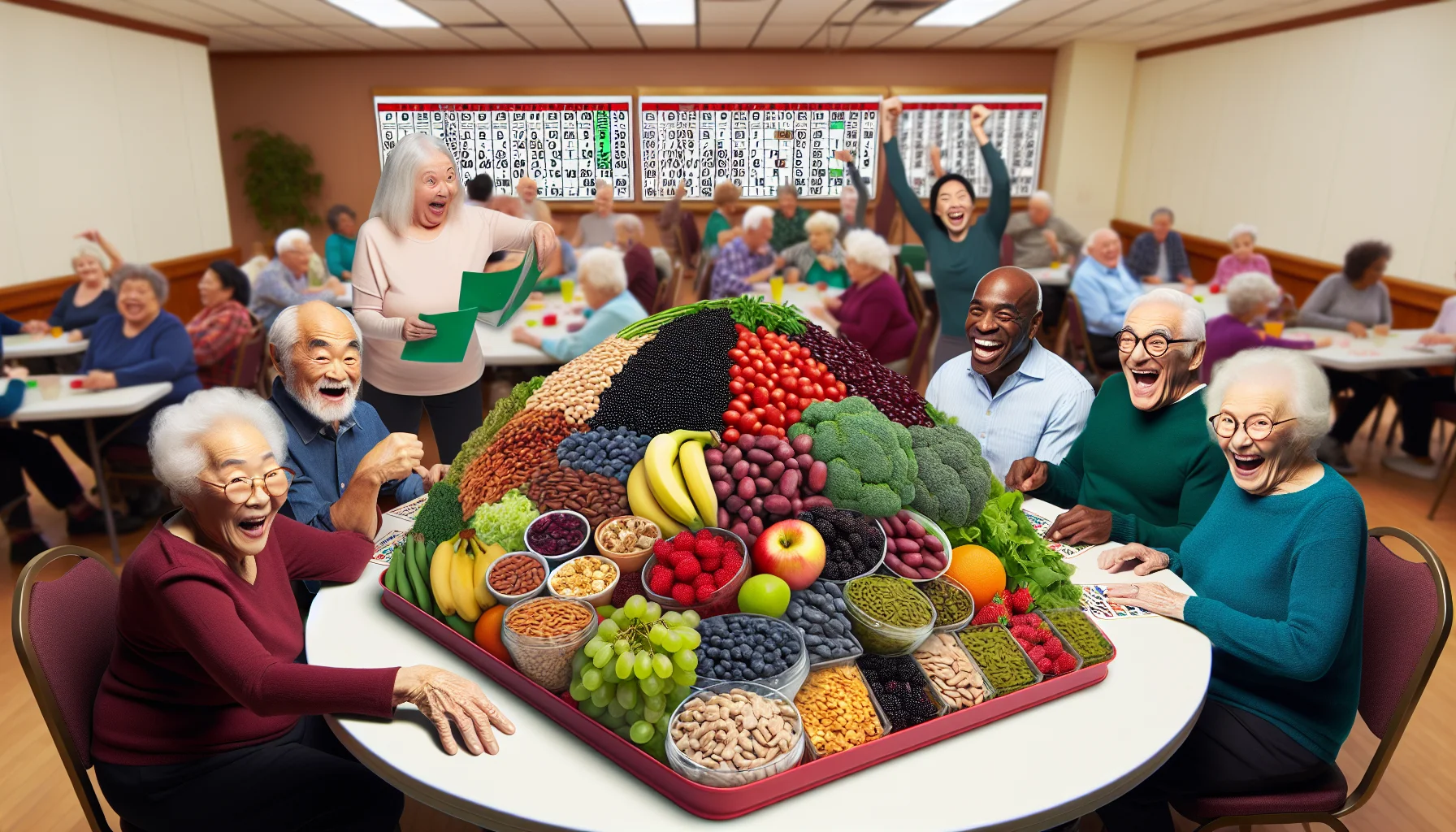High fiber vegan foods Quiz
Test Your Knowledge
Question of
Understanding High Fiber Vegan Foods
The Importance of Fiber in a Vegan Diet
Fiber is a vital component of a vegan diet, playing a key role in maintaining digestive health and regularity. As plant-based eaters, vegans have an extensive array of fiber-rich foods at their disposal. Incorporating these foods ensures that the diet not only supports gut health but also contributes to overall well-being.
A diet rich in fiber can also aid in weight management and blood sugar control. For vegans, fiber intake is naturally higher due to the consumption of fruits, vegetables, whole grains, and legumes. This abundance of dietary fiber can lead to reduced risk of chronic diseases such as type 2 diabetes and cardiovascular disease.
Health Benefits of Dietary Fiber
Dietary fiber offers numerous health advantages beyond just aiding digestion. It's associated with lower cholesterol levels and plays a role in preventing certain cancers. Soluble fiber, for instance, has been shown to reduce bad cholesterol by binding with it in the digestive system, thereby removing it from the body.
Fiber also acts as a prebiotic, providing nourishment for beneficial gut bacteria. These microbes are essential for a healthy immune system and synthesizing important nutrients like vitamin K and B vitamins. High-fiber diets thus contribute to a robust gut microbiome, enhancing overall health.
Recommended Daily Fiber Intake
The recommended daily intake of fiber varies depending on age and sex. On average, women should aim for about 25 grams per day, while men should target around 38 grams. However, most people consume much less than these amounts. Vegans typically exceed these recommendations due to their plant-heavy diets.
To meet these fiber goals, it's crucial to include a variety of high-fiber foods throughout the day. Consuming whole fruits instead of juices, adding beans to salads, and choosing whole grain options can significantly boost fiber intake. Paying attention to food labels can also help track daily consumption.
Identifying High Fiber Foods Suitable for Vegans
Vegans have access to an extensive range of foods that are both high in fiber and align with their dietary choices. Fruits like berries and apples are excellent sources of dietary fiber that are easy to incorporate into meals or snacks. Vegetables such as broccoli and Brussels sprouts not only provide necessary nutrients but also pack a fibrous punch.
- Whole Grains: Quinoa, oats, barley, and brown rice are whole grains that serve as fantastic sources of fiber.
- Legumes: Beans, lentils, chickpeas contain significant amounts of fiber alongside protein.
- Nuts and Seeds: Almonds, chia seeds, flaxseeds offer both healthy fats and fiber.
Whole Grains as a Fiber Source
Whole grains are a powerhouse when it comes to providing dietary fiber for vegans. Consuming grains like quinoa or brown rice guarantees not only high-quality carbohydrates but also an impressive dose of fiber which is often lacking in refined grain products.
Including various whole grains in meals ensures diversity in nutrient intake while keeping meals interesting. Whether it's starting the day with oatmeal or ending it with millet-stuffed peppers, whole grains are versatile allies in meeting dietary fiber needs.
Legumes, Nuts, and Seeds
Legumes stand out as one of the best high-fiber food groups suitable for vegans. They're versatile ingredients that can be added to soups, salads, or main dishes. Beyond their high-fiber content, they're also packed with protein making them an excellent meat substitute for vegans.
Nuts and seeds may be small but they're mighty sources of both nutrients and fiber. Incorporating them into diets is easysprinkle them over salads or blend them into smoothies for an extra nutrient kick. They not only add texture and flavor but also boost your daily intake of dietary fiber substantially.
Planning Your High Fiber Vegan Meals
Creating Balanced Vegan Meals with Adequate Fiber
A well-rounded high fiber vegan meal is a powerhouse of nutrition, combining various plant-based foods to meet dietary needs. It's essential to include a mix of fruits, vegetables, whole grains, legumes, nuts, and seeds to ensure you're getting both soluble and insoluble fiber. This balance aids in digestion and provides sustained energy throughout the day.
When creating your meals, aim for color and variety. For example, a vibrant salad with mixed greens, chickpeas, berries, and flax seeds not only looks appealing but also packs a substantial fiber punch. The diversity of ingredients ensures a broad spectrum of vitamins and minerals that support overall health.
Sample High Fiber Vegan Meal Plan
Kick off your day with oatmeal topped with chia seeds, banana slices, and a sprinkle of almonds for breakfast. Lunch could be a hearty lentil soup accompanied by a quinoa and veggie salad. For dinner, explore the flavors of a stir-fry brimming with tofu and fiber-rich vegetables like broccoli and bell peppers served over brown rice.
Snacks are an opportunity to boost your fiber intake further. Think apple slices with peanut butter or whole grain crackers with hummus. These options not only satisfy hunger but also contribute to your daily fiber goals.
Tips for Incorporating More Fiber into Your Diet
- Start Slowly: Gradually increase fiber intake to prevent digestive discomfort.
- Vary Your Sources: Get fiber from different foods to benefit from a range of nutrients.
- Read Labels: Choose products with high fiber content when shopping for breads, cereals, and snacks.
- Keep Hydrated: Drink plenty of water as you up your fiber intake to help manage digestion.
- Snack Smart: Opt for fresh fruit, nuts, or air-popped popcorn instead of low-fiber junk food.
- Cook Creatively: Use whole grains like barley or bulgur to add texture and fiber to soups and salads.
Overcoming Common Challenges in a High Fiber Vegan Diet
Incorporating more fiber into your diet can lead to initial digestive issues such as bloating or gas. To minimize these effects, increase your fiber intake gradually over several weeks. This allows your digestive system to adjust without discomfort. Also important is staying hydrated; water helps move fiber through the digestive tract more smoothly.
Balancing flavors and textures can make high-fiber foods more palatable and enjoyable. Experiment with herbs and spices to enhance the taste of legumes and grains. Combining crunchy seeds or nuts with soft cooked vegetables can also improve the eating experience by adding contrasting textures that keep meals interesting.
Managing Increased Fiber Intake
Paying attention to how your body responds to increased fiber is crucial in managing its intake effectively. If you experience any adverse reactions, it may be worth examining which specific foods are causing them and adjusting accordingly. Keeping a food diary can help identify patterns related to digestive discomfort.
Maintaining variety in your diet is not only key for nutritional adequacy but also helps in managing fiber intake without overwhelming the digestive system. Including a wide range of high-fiber foods ensures that you'll get the benefits without excessive consumption from any single source.
Ensuring Nutritional Adequacy
To ensure nutritional adequacy on a high fiber vegan diet, it's vital to consume enough protein-rich plant foods like lentils, beans, tofu, tempeh, and edamame. These sources often come packed with additional benefits like iron and zinc which are crucial for maintaining good health on a vegan diet.
Focusing on whole foods rather than processed options will naturally enhance the nutrient density of your meals. Supplements may be necessary for some individualsespecially for vitamin B12 which is not readily available in plant-based dietsso consider consulting with a nutritionist or healthcare provider for personalized advice based on your specific needs.
Top High Fiber Vegan Recipes
Breakfast Ideas to Kickstart Your Day
Begin your morning with a burst of energy! High-fiber vegan breakfasts are not just nourishing, they're absolutely delicious and will keep you satiated until lunch. From smoothie bowls packed with seeds and fruits to whole-grain toast toppings, the options are both endless and exciting. Embrace the power of a fiber-rich start to your day!
Imagine the perfect balance of taste and healthyes, it's possible with high-fiber vegan breakfasts! They're designed to support digestive health and maintain steady blood sugar levels, which is crucial for that morning boost. Plus, they're incredibly versatile, allowing you to mix and match ingredients based on what's in season or what you have on hand.
High Fiber Smoothies and Bowls
Dive into a colorful world of high fiber smoothies and bowls that are as appealing to the eye as they are beneficial for your body. Blend dark leafy greens with ripe berries, toss in some chia seeds or flaxseeds for an extra fiber kick, and top it off with crunchy nuts. Each sip or spoonful is a step towards optimal health!
Don't underestimate the power of a well-crafted bowl! Combining various textures from creamy bananas to crispy apples, and including superfoods like acai or spirulina, can turn your ordinary bowl into a fiber powerhouse. It's a game-changer for those looking to increase their nutrient intake effortlessly.
Hearty Vegan Oatmeal and Pancakes
Oatmeal doesn't have to be boring! By incorporating fruits like berries or mashed banana, nuts, seeds, and even a sprinkle of cinnamon or nutmeg, your oatmeal transforms into a high-fiber feast. It's time to redefine this classic breakfast dish and make it not just filling but utterly irresistible!
Pancakes are synonymous with indulgence, but who says they can't be healthy? Whip up fluffy high-fiber pancakes using whole wheat flour or oat flour; add bananas or applesauce for natural sweetness and moisture. Serve these golden beauties with a drizzle of maple syrup or a dollop of almond butter for an extra treat that fuels your day!
Satisfying High Fiber Lunches and Dinners
Lunches and dinners that are rich in fiber ensure that your energy levels remain consistent throughout the day. Embrace legumes, whole grains, and an abundance of veggies in your meals. These ingredients form the cornerstone of satiating high-fiber lunches and dinners that promise taste without compromising on nutrition.
The beauty of vegan cuisine shines through its ability to combine simplicity with depth of flavorespecially when it comes to high-fiber meals. Get creative with spices and herbs; let them dance together with fibers from beans, lentils, quinoa, or brown rice. You'll be crafting dishes that delight both your palate and your digestive system.
Protein-Packed Salads and Bowls
Fancy a rainbow on your plate? Construct protein-packed salads bursting with colorthink vibrant greens, reds from bell peppers or tomatoes, oranges from carrots or sweet potatoesall sprinkled with hearty beans or lentils. This isn't just food; this is art that nourishes every cell in your body.
- Add diverse textures: Include crunchy nuts or seeds along with soft beans.
- Mix fresh & cooked elements: Pair raw spinach with roasted veggies.
- Dress it up: A zesty lemon-tahini dressing can elevate the whole experience.
- Grain goodness: Quinoa or farro can add substance to any salad.
- Garnish generously: Fresh herbs bring brightness to every bite.
- Consider color: Make your bowl visually appealing; eat with your eyes first!
Hearty Soups and Stews
There's nothing quite like the comfort of a warm bowl of soup or stewespecially when it's packed full of fiber-rich ingredients! Imagine spooning through layers of flavor from slow-cooked veggies, beans simmering in rich tomato broth spiced just right. These meals are not only heartwarming but also provide ample nutrition.
A stew can serve as a canvas for culinary creativity. Whether its throwing in some kale for its fibrous benefits or blending cashews for creaminess without dairyeach ingredient adds its own unique touch. And lets not forget about soups' best friendwhole grain bread for dippingits the perfect complement for these liquid treasures!
The Role of Fiber in Weight Management
How Fiber Contributes to Satiety and Weight Control
Fiber plays a crucial role in weight management by enhancing feelings of fullness. This is because high-fiber foods take longer to eat and digest, leading to a slower rise in blood sugar. As a result, you feel satiated for extended periods, which can help reduce overall calorie intake.
Another key benefit of fiber is its ability to bind with fats and sugars, which slows their absorption and helps maintain stable energy levels. This process can prevent sudden hunger spikes that often lead to overeating. By incorporating more fiber into your diet, you're setting the stage for sustainable weight management.
The Science Behind Fiber and Fullness
Dietary fiber has the incredible ability to expand in the stomach, adding bulk without extra calories. Soluble fiber forms a gel-like substance when mixed with water, which increases the volume of food in your gut. This expansion triggers stretch receptors that signal fullness to the brain.
Fiber's fermentation process in the large intestine also plays a part in satiety. Short-chain fatty acids produced during fermentation may regulate appetite hormones, further contributing to a feeling of fullness. The science is clear: fiber is a formidable ally in the fight against unnecessary snacking!
Fiber's Impact on Metabolism and Fat Loss
Fiber doesn't just fill you upit also revs up your metabolism! By regulating blood sugar levels, high-fiber foods prevent insulin spikes that can lead to fat storage. A steady insulin level allows the body to burn fat more effectively as fuel.
Moreover, the effort required to break down fibrous foods means your body burns more calories during digestionthis phenomenon is known as the thermic effect of food (TEF). Eating high-fiber meals can therefore boost metabolic rate and support fat loss efforts.
Designing a High Fiber Diet for Weight Loss
Creating a high-fiber diet for weight loss starts with choosing a variety of fiber-rich foods like fruits, vegetables, legumes, and whole grains. These foods are not only packed with fiber but also essential nutrients that support overall health. They're low in calories yet dense in volume, making them perfect for filling up without overindulging.
- Start Slowly: Gradually increase fiber intake to avoid gastrointestinal discomfort.
- Stay Hydrated: Drink plenty of water as you up your fiber intake to aid digestion.
- Variety Matters: Include different types of fiber-rich foods to get a mix of soluble and insoluble fibers.
- Read Labels: Choose whole food options over processed foods that often contain added sugars despite being high in fiber.
- Consistency is Key: Maintain consistent daily fiber intake for best results.
- Avoid Excess: Too much fiber can lead to bloating or discomfort; stick within recommended guidelines.
- Beware of 'Fiber-Fortified': Some products add synthetic fibers which may not provide the same benefits as natural sources.
To maximize weight loss benefits, it's important to focus on calorie control while eating high-fiber foods. This doesn't mean merely eating less; it's about making smarter food choices that provide the most satiation per calorie consumed. Opt for whole, unprocessed foods that deliver maximum nutrition with minimum calories.
Paying attention to portion sizes and meal timing can further enhance the effectiveness of a high-fiber diet. Eating smaller portions throughout the day can keep energy levels stable and prevent overeating during main meals. Timing your intake so that you consume more fiber at times when you're likely to feel hungrier can also help manage appetite throughout the day.
Digestive Health and High Fiber Vegan Diets
Improving Gut Health with Plant-Based Fibers
The vegan diet, rich in fruits, vegetables, legumes, and whole grains, is a treasure trove of dietary fiber. This type of fiber serves as a bulwark for your digestive system, promoting regular bowel movements and reducing the risk of constipation. It's the cornerstone of a thriving gut environment!
A high-fiber vegan diet not only aids in digestion but also helps maintain a healthy weight. By incorporating plant-based fibers into your meals, you're opting for foods that keep you feeling full longer, which can prevent overeating. It's like hitting two birds with one stone weight management and digestive bliss!
Prebiotics: Fuel for Healthy Gut Bacteria
Prebiotics are the unsung heroes residing in high-fiber foods like garlic, onions, and bananas. They act as fuel for probioticsthe good bacteria in your gut. This dynamic duo works synergistically to enhance your immune system and improve nutrient absorption.
Regular intake of prebiotic-rich foods can lead to a flourishing microbiome. Imagine billions of beneficial bacteria working tirelessly to fortify your health! This is the power of a high-fiber vegan diet it's essentially cultivating a garden of wellness within you.
Combating Digestive Disorders with Fiber
It's no secret that fiber is a formidable foe against various digestive disorders such as diverticulitis and IBS (Irritable Bowel Syndrome). A consistent intake of dietary fiber from plant sources can help soothe the symptoms associated with these conditions.
By embracing a high-fiber vegan diet, you're enveloping your digestive tract in a protective layer that can stave off inflammation and discomfort. Think of it as equipping your body with the right tools to fight back against digestive distress.
Balancing Fiber Intake for Optimal Digestion
The transition to a high-fiber vegan diet should be gradual to allow your body to adapt without discomfort. Starting slowly will help minimize any initial bloating or gas, which are common side effects as your digestive system adjusts to this bountiful influx of fiber.
Remember, hydration is key! Drinking plenty of water enhances fiber's benefits, making it easier for food to travel through your system. Picture each glass of water as an aid helping fiber do its job more efficiently it's essential for smooth operations!
Adjusting to Increased Fiber Consumption
- *Start with small increases in fiber-rich foods to give your digestive system time to adjust. *Pair increased fiber intake with ample fluids; aim for at least 8 glasses of water per day. *Chew food thoroughly to aid digestion and decrease the workload on your gut. *Spread out fiber consumption throughout the day rather than consuming it all at once. *Listen to your body's signals and adjust accordingly; if you experience discomfort, scale back and then gradually increase again. *Consider incorporating fermented foods like kimchi or sauerkraut which can help ease digestion. *Include a variety of fiber sources in your diet to benefit from different types of dietary fiber. *Consult with a healthcare provider or dietitian if you have existing digestive issues before making significant changes to your diet.
Dealing with Gas and Bloating
Gas and bloating are common when starting a high-fiber vegan diet; however, these symptoms usually subside as the body acclimates. To mitigate these effects, integrate fibrous foods gradually and consider using over-the-counter remedies like simethicone if needed.
If bloating persists or becomes bothersome, assess your food choices. Some individuals may find certain legumes or cruciferous vegetables more gas-producing than others. Experimentation is key find what works best for you and tailor your diet accordingly!
Nutrient-Dense High Fiber Food Sources
Superfoods in the High Fiber Vegan Pantry
Transform your pantry into a powerhouse of fiber with vegan superfoods! Foods like chia seeds, flaxseeds, and almonds are not just rich in fiber; they're also loaded with nutrients that support overall health. These superfoods can easily be incorporated into daily meals, ensuring you're getting that extra fiber boost without compromising on taste or variety.
Diversifying your high fiber intake is key. Avocado, for instance, offers a creamy texture along with its fiber content, making it a versatile addition to any meal. With these superfoods at your fingertips, you'll be well-equipped to meet your dietary needs in delicious and innovative ways!
The Power of Berries and Fruits
Berries like raspberries, blackberries, and blueberries are tiny titans in the realm of fiber-rich fruits. Not only do they pack a potent punch of dietary fiber, but they are also brimming with antioxidants. Integrating these fruits into your diet can help support digestive health and provide essential vitamins.
Fruits such as apples and pears retain more fiber when eaten with their skins on. They're perfect for snacking and can be a simple yet effective step towards reaching your daily fiber goals. Embrace the natural sweetness and fibrous benefits of these fruits to enhance your overall well-being!
Greens and Cruciferous Vegetables for Fiber Boost
Leafy greens like spinach and kale are not just low in caloriesthey're also high-fiber champions that contribute to satiety and digestive health. These vegetables are incredibly adaptable, fitting seamlessly into salads, smoothies, or as cooked sides. Their nutrient density makes them an essential part of any high-fiber diet.
Cruciferous vegetables such as broccoli and Brussels sprouts stand out for their impressive fiber content. Regular consumption can aid in maintaining a healthy digestive system while providing a bounty of vitamins and minerals. Incorporate these vegetables into your meals for a robust supply of dietary fiber.
Grains, Legumes, and Seeds with Maximum Fiber Content
The world of grains offers more than just rice and wheat; there's a whole spectrum waiting to be explored. Whole grains like quinoa and barley provide substantial amounts of fiber alongside protein and complex carbohydrates. These grains serve as excellent bases for a variety of dishesthink salads, soups, or even as standalone sides!
Seeds such as chia seeds offer an extraordinary amount of fiber per serving. They can easily be added to yogurts, smoothies, or baked goods to enhance texture and nutritional value. Seeds are small but mighty components of a high-fiber diet that should not be overlooked.
Quinoa, Barley, and Other Whole Grains
Quinoa is not just gluten-free; it's also a complete protein source brimming with fiber! Its versatility makes it perfect for breakfast bowls or hearty dinners. Similarly, barley is another grain that provides ample fiber while lending a satisfying chewiness to dishes.
Oats are another fantastic choice for those seeking high-fiber grains. Starting the day with oatmeal can help keep you full until lunchtime while contributing significantly to your daily fiber intake. Whole grains like these are fundamental building blocks for any high-fiber diet.
Lentils, Chickpeas, and Beans as Staple Foods
- *Enumerative Lists: Used for itemizing elements or tasks. Ordered Lists: Sequence matters (e.g., procedural steps). Unordered Lists: Sequence does not matter (e.g., grocery lists). *Descriptive Lists: Each item comes with additional details. *Checklists: For tracking completion or presence. *Multilevel Lists: Nested lists with items having sub-items. *Matrix Lists: Presented in grid format. *Priority Lists: Items organized by importance. *Comparative Lists: For juxtaposing two or more items.
The Connection Between High Fiber Foods and Disease Prevention
Fiber's Role in Reducing Risk of Chronic Diseases
Fiber is a powerhouse when it comes to maintaining good health and preventing diseases. A diet rich in high fiber foods can lower the risk of developing several chronic conditions. This is because fiber aids digestion, helps regulate blood sugar levels, and supports overall gut health. Moreover, it's not just about eating any fiber; the type, quality, and variety of fiber all play crucial roles.
Integrating high fiber foods into your diet can be a game-changer for your health. Dietary fibers found in fruits, vegetables, whole grains, and legumes have been linked to a reduced risk of cardiovascular diseases. They help manage body weight by increasing satiety, which in turn can reduce the likelihood of overeating.
Heart Health and Cholesterol Management
Fiber has a direct impact on heart health by aiding in the management of cholesterol levels. Soluble fiber, in particular, binds with cholesterol particles and helps flush them out of the body. This process can lead to a significant decrease in the bad LDL cholesterol levels, thereby reducing the risk of heart disease and stroke.
People who consume high amounts of fiber tend to have lower rates of heart disease. The reason behind this is that fiber-rich diets contribute to lower blood pressure and inflammation, which are key factors in protecting against heart disease.
Diabetes Prevention and Blood Sugar Regulation
Eating plenty of high-fiber foods is crucial for blood sugar regulation, which can help prevent Type 2 diabetes. Fibers slow down the absorption of sugar, assisting in maintaining stable glucose levels. For those already living with diabetes, dietary fiber can improve insulin sensitivity.
To truly harness the power of fiber for diabetes prevention, consistency is key. Regular consumption of dietary fiber has been shown to lower hemoglobin A1c levels, an indicator of long-term blood sugar control.
The Anti-Inflammatory Effects of a High Fiber Vegan Diet
Fighting Inflammation with Plant-Based Foods
A plant-based diet rich in high-fiber foods can work wonders in reducing inflammation within the body. Fiber can alter the composition of gut bacteria and produce short-chain fatty acids that have anti-inflammatory properties. This is especially beneficial for individuals suffering from inflammatory diseases.
- Eat a variety of fruits: Berries, oranges, and apples are great choices.
- Include legumes: Beans and lentils are not only high in protein but also rich in fiber.
- Opt for whole grains: Choose brown rice or whole wheat over refined grains.
- Sneak veggies into meals: Add spinach to smoothies or peppers to omelets.
- Nuts and seeds: A handful of almonds or chia seeds can boost your daily intake.
- Mind your gut health: Probiotics from yogurt or fermented foods complement high-fiber diets.
- Hydrate adequately: Water helps fiber do its job better by preventing constipation.
- Avoid processed foods: They often lack dietary fiber and contain added sugars or unhealthy fats.
Long-Term Health Benefits of Anti-Inflammatory Eating
The long-term benefits of an anti-inflammatory diet extend far beyond immediate discomfort relief. Consistently consuming high-fiber plant-based foods can lead to lasting improvements in health markers such as reduced incidence of certain cancers and better mental health outcomes due to decreased oxidative stress.
An anti-inflammatory diet isn't just about adding more plants to your plate; it's about creating a sustainable pattern of eating that supports your body's natural defenses against disease. Embrace this lifestyle change with excitement for all the positive transformations it will bring!
Integrating High Fiber Foods into Your Lifestyle
Making the Transition to a High Fiber Vegan Diet Smoothly
Embarking on a high fiber vegan journey is exhilarating! The key is to start slow; introduce high-fiber foods gradually. This allows your digestive system to adapt without discomfort. Begin by incorporating legumes, whole grains, and a variety of vegetables into your meals.
Exploring the world of high fiber doesn't have to be daunting. There's a treasure trove of resources at your fingertips! Connect with online communities, download meal planning apps, and check out vegan cookbooks. Arm yourself with knowledge, and you'll navigate this transition like a pro!
Gradually Increasing Fiber Intake
Skyrocketing your fiber intake overnight may backfire, so pace yourself. Start by adding an extra serving of vegetables to your plate or swapping out refined grains for their whole counterparts. Listen to your body's cues as you fine-tune your fiber intake.
Finding Support and Resources for Dietary Changes
You're not alone on this journey! Seek out local or online vegan groups for support. Sharing experiences and recipes can transform the dietary overhaul into an exciting adventure. Remember, guidance from nutrition experts can also pave the way for a smooth transition.
Sustaining a High Fiber Vegan Diet in the Long Term
Longevity in any diet requires preparation. Meal prepping is your secret weapon; it ensures you have high-fiber meals ready at all times. Dedicating a few hours each week to prepare beans, chop veggies, or cook quinoa will save you time and keep you on track.
Variety isn't just the spice of lifeit's essential for maintaining any dietary lifestyle! Rotate through different fruits, veggies, grains, and legumes to keep things exciting. Experiment with international cuisines that celebrate plant-based ingredients for an endless array of delicious options.
Meal Prepping for Success
- Plan your meals in advance to avoid last-minute decisions that might be less healthy.
- Invest in quality containers that keep food fresh and make portions easily accessible.
- Prepare versatile base ingredients like brown rice or lentils that can be used in multiple recipes throughout the week.
- Budget time effectively by cooking in batches this approach works wonders for both efficiency and consistency!
Staying Motivated with Varied Food Choices
To keep your taste buds tantalized, get creative in the kitchen! Try new recipes regularly and don't shy away from exotic spices and herbs. This strategy keeps meals interesting and helps prevent dietary boredom.
Reward yourself occasionally with vegan treats that are high in fiber yet indulgent. Dark chocolate with nuts or a homemade berry crumble can satisfy sweet cravings while aligning with your high-fiber goals. Balance is key!












